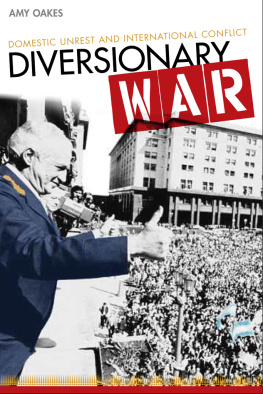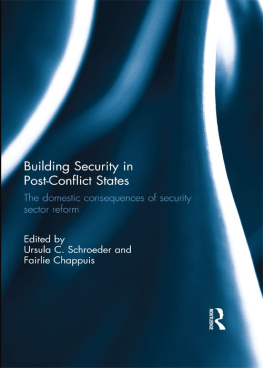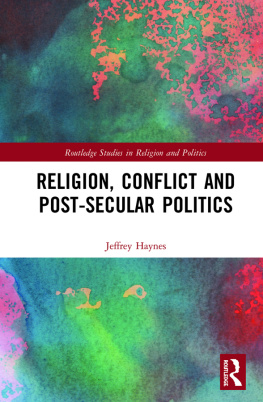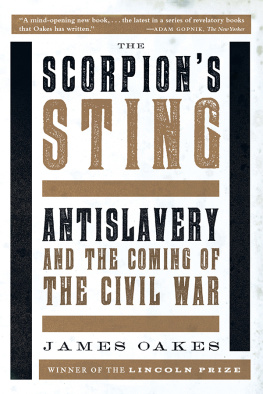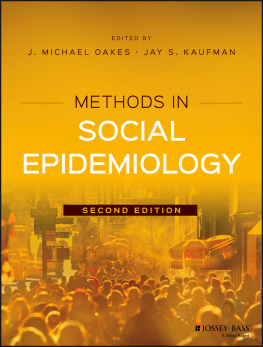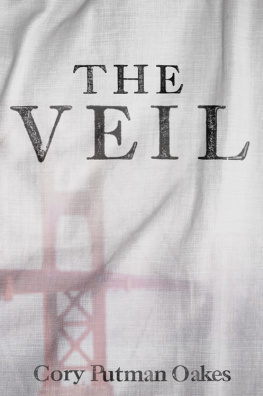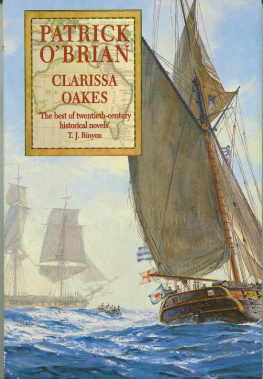Stanford University Press
Stanford, California
2012 by the Board of Trustees of the Leland Stanford Junior University. All rights reserved.
No part of this book may be reproduced or transmitted in any form or by any means, electronic or mechanical, including photocopying and recording, or in any information storage or retrieval system without the prior written permission of Stanford University Press.
Printed in the United States of America on acid-free, archival-quality paper
Library of Congress Cataloging-in-Publication Data
Oakes, Amy, author.
Diversionary war : domestic unrest and international conflict / Amy Oakes.
Pages cm
Includes bibliographical references and index.
ISBN 978-0-8047-8245-6 (cloth : alk. paper)
ISBN 978-0-8047-8246-3 (pbk. : alk. paper)
ISBN 978-0-8047-8493-1 (e-book)
1. Politics and war. 2. WarCauses. 3. Political stability. 4. WarDecision making. 5. International relationsDecision making. I. Title.
JZ6385.O35 2012
355.0272dc23
2011052156
Special discounts for bulk quantities of Stanford Security Studies are available to corporations, professional associations, and other organizations. For details and discount information, contact the special sales department of Stanford University Press. Tel: (650) 736-1782. Fax: (650) 736-1784.
Typeset by Newgen in 10/14 Minion
D IVERSIONARY WAR
Domestic Unrest and International Conflict
Amy Oakes
Stanford Security Studies
An Imprint of Stanford University Press
Stanford, California
To my parents, Jack Stanley and Ginger
Contents
Tables and Figures
Tables
Figures
Acknowledgments
It gives me great pleasure to thank the many colleagues and friends who helped me complete this project. While I was a graduate student at the Ohio State University, Janet Box-Steffensmeier, Yoav Gortzak, Yoram Haftel, Richard Herrmann, Elizabeth Kloss, Richard Ned Lebow, John Mueller, David Rowe, Goldie Shabad, Kevin Sweeney, Donald Sylvan, Sean Williams, and, especially, the chair of my dissertation committee, Brian Pollins, each made integral contributions to this research. Thomas Christensen and Jack Snyder offered valuable guidance in the early stages of the project.
I am fortunate to work with an outstanding group of scholars at the College of William and Mary. Paul Manna, Christine Nemacheck, Susan Peterson, Simon Stow, and Michael Tierney provided wise council and encouragement as I navigated the perils of writing a book.
Dennis Smith deserves special thanks for the many excellent suggestions that advanced the manuscript. Michael Horowitz also offered incisive comments that substantially sharpened the theoretical argument. Dangers abound when political scientists engage in historical analysis, and William MacKinnon and Roger Ransom provided expert critiques of the chapter on the U.S. expedition to Utah. Matt Golder, Robert Hicks, Ross Iaci, Stephen Shellman, and Alicia Uribe helped to unravel particularly knotty challenges with the statistical analysis. My gratitude also goes to the wonderful William and Mary studentsDavid Newbrander, Hannah Thornton, and Alena Sternwho tidied up the footnotes and bibliography. Churchill and Nimbus also left their footprints throughout the manuscript.
The book was completed during my sabbatical leave, which was generously funded by the College of William and Mary and a grant from the John D. and Catherine T. MacArthur Foundation. I also benefited greatly from my years as a pre-doctoral fellow at the Mershon Center for International Security Studies and as a research fellow at the Belfer Center for Science and International Affairs.
For his early interest in the book and for shepherding it through the publication process, I am grateful to Geoffrey Burn at Stanford University Press. And I would like to thank Security Studies for granting permission to reprint parts of my article Diversionary War and Argentinas Invasion of the Falkland Islands (Security Studies 15, no. 3 [JulySeptember 2006], copyright Taylor & Francis Group, LLC; reprinted by permission of Taylor & Francis, http://www.tandfonline.com).
I would also like to thank my mentors and teachers at Davidson College, who shared with me their time, wisdom, and love of politics: Peter Ahrensdorf, Kenneth Menkhaus, Louis Ortmayer, Brian Shaw, and Mary Thornberry.
I am deeply indebted to Dominic Tierney. His superb ideas and ready wit were necessary conditions for the completion of this book.
For their love and unflagging support, I dedicate this book to my parents.
Introduction
Be it thy course to busy giddy minds
With foreign quarrels; that action, hence borne out,
May waste the memory of the former days.
William Shakespeare, Henry IV, Part 2
In the late summer of 1998, at the height of the Monica Lewinsky scandal, U.S. President Bill Clinton authorized air strikes against alleged terrorist targets in Sudan and Afghanistan. Several Clinton critics asserted that the bombings were intended to shift focus from the presidents admission that he had lied about having an improper relationship with White House intern Lewinsky. In a Salon editorial, for example, Christopher Hitchens wondered why the president hurried to attack: There is really only one possible answer to that question. Clinton needed to look presidential for a day.
Indeed, on several occasions the administrations top national security aides were compelled to deny publicly that the attacks were linked to the presidents personal and legal troubles. For example, Secretary of Defense William Cohen was asked during a press conference whether he had seen the movie Wag the Dog, in which a Washington spin doctor fabricates a war to distract the public from the presidents liaison with a teenage girl. Cohen declined to answer directly, saying that The only motivation driving this action today was our absolute obligation to protect the American people from terrorist activities.
Despite the administrations emphatic denials, the event exhibited many hallmarks of a classic diversionary use of force, which is to say an international conflict provoked to whip up nationalist sentiment and rally the populace behind the regime or simply to distract the public from the governments failings. First, the timing was felicitous. Clinton gave the mission a green light on the same day he was asked to provide federal investigators with a DNA sample, which signaled that the Starr Commission had potentially damning forensic evidence of intimate contact with Lewinsky. The White House also announced the strikes just three days after Clintons prime-time television appearance, in which he confessed to a critical lapse in judgment, a personal failure in having an affair with Lewinsky. And the attacks themselves coincided with Lewinskys second and final grand jury appearance, in which she was questioned about the veracity of Clintons testimony.
Second, the operation was generally popular. The target, Osama bin Ladens terrorist network, was believed to be responsible for the deadly bombing of American embassies in Kenya and Tanzania. As a result, even the Republican leadership praised Clintons decision to use force. House Speaker Newt Gingrichs reaction was typical when he remarked that if you saw the TV coverage of the two embassy bombings and the caskets come home to America, you know that this is real.... I think, based on what I know, that it was the right thing to do at the right time. The American public may have distrusted their president, but they also believed that he was a capable commander-in-chief. Whatever Clintons actual motivation, the attacks changed the national conversation from sordid assignations in the Oval Office to combating global terrorism.

